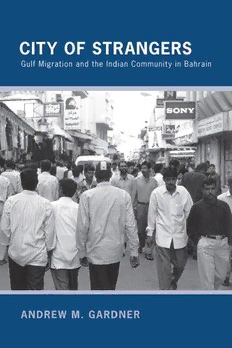
City of Strangers: Gulf Migration and the Indian Community in Bahrain PDF
Preview City of Strangers: Gulf Migration and the Indian Community in Bahrain
CITY OF STRANGERS CITY of STRANGERS Gulf Migration and the Indian Community in Bahrain Andrew M. Gardner ilr press an imprint of cornell university press Ithaca and London Copyright © 2010 by Cornell University All rights reserved. Except for brief quotations in a review, this book, or parts thereof, must not be reproduced in any form without permission in writing from the publisher. For information, address Cornell University Press, Sage House, 512 East State Street, Ithaca, New York 14850. First published 2010 by Cornell University Press First printing, Cornell Paperbacks, 2010 Printed in the United States of America Library of Congress Cataloging-in-Publication Data Gardner, Andrew, 1969– City of strangers : Gulf migration and the Indian community in Bahrain / Andrew M. Gardner. p. cm. Includes bibliographical references and index. ISBN 978-0-8014-4882-9 (cloth : alk. paper) — ISBN 978-0-8014-7602-0 (pbk. : alk. paper) 1. Foreign workers, East Indian—Bahrain. 2. East Indians—Bahrain. 3. Foreign workers, East Indian—Violence against—Bahrain. 4. East Indians—Violence against—Bahrain. 5. India—Emigration and immigration. 6. Bahrain—Emigration and immigration. 7. Bahrain—Ethnic relations. 8. Ethnology—Bahrain. I. Title. HD8668.G37 2010 331.62'5405365—dc22 2010002267 Cornell University Press strives to use environmentally responsible suppliers and materials to the fullest extent possible in the publishing of its books. Such materials include vegetable-based, low-VOC inks and acid-free papers that are recycled, totally chlorine-free, or partly composed of nonwood fi bers. For further information, visit our website at www.cornellpress.cornell.edu. Cloth printing 10 9 8 7 6 5 4 3 2 1 Paperback printing 10 9 8 7 6 5 4 3 2 1 Cover photograph by Kristin Giordano. For S. K. and my parents, Gordon and Janice Gardner CONTENTS Acknowledgments ix 1. Introduction: Structural Violence and Transnational Migration in the Gulf States 1 2. Pearls, Oil, and the British Empire: A Short History of Bahrain 24 3. Foreign Labor in Peril: The Indian Transnational Proletariat 49 4. Strategic Transnationalism: The Indian Diasporic Elite 71 5. The Public Sphere: Social Clubs and Voluntary Associations in the Indian Community 96 6. Contested Identities, Contested Positions: English-Language Newspapers and the Public Sphere 118 7. The Invigorated State: Transnationalism, Citizen, and State 136 8. Conclusion: Bahrain at the Vanguard of Change in the Gulf 159 Notes 165 References 175 Index 185 vii ACKNOWLEDGMENTS In anthropological parlance, “key informants” are those individ- uals native to the communities we study who emerge as integral to the anthropologist’s inquiry. Although I found many individuals willing to share their time and thoughts with me, I hesitate to call them “informants,” for that title somehow seems too formal and oddly traitorous to stand for these relationships. There were many individuals whose contributions were essential to the writing of this book, but those who proved most key were foremost my friends, and our afternoons and evenings spent drinking cof- fee, carousing through the nightlife of Bahrain, sharing a meal, walking along the corniche, or smoking sheesha yielded a lively intellectual atmo- sphere that made my time on the island all the more enjoyable. With that caveat in mind, I foremost thank S.K. for taking me under his wing. A pharmacist by training, he was born with a seemingly boundless desire to make the world a better place, a trait readily apparent in his unyielding penchant for service to those less fortunate. This book would not have been possible without his help. I also thank Ashish Gorde and Dhafi al-Mannai, both good friends, and Naman Arora, a student at the Indian School who somehow found the time to serve as my fi eld assistant. Many others helped me along the way: Dr. R. K. Hebsur, Pragati, Mohammed, Earsil, Veena, Joel, Timothy, Aisha, Suresh, Vani, and all the students in the 2003 ILA English course I taught. Shortly before arriving in Bahrain I met with Dr. Sharon Nagy, a cul- tural anthropologist interested in many of the same issues that brought me to the island. What could have ended up as a diffi cult relationship—two ethnographers with the same interests on a small island—ended up just ix
